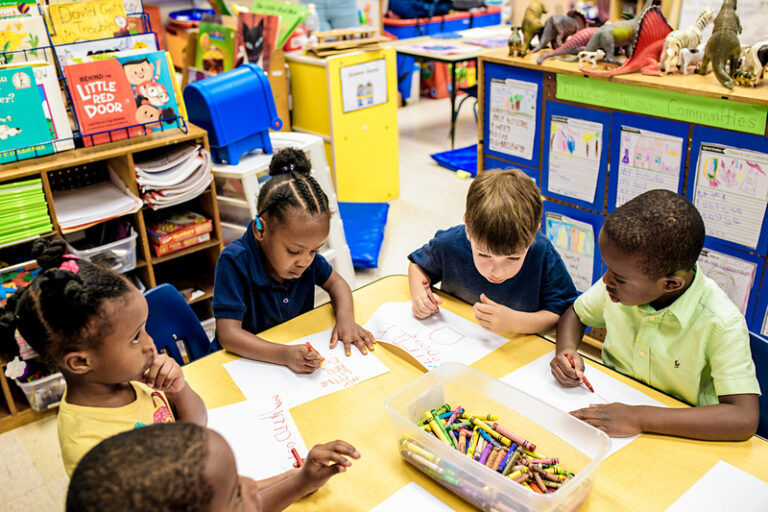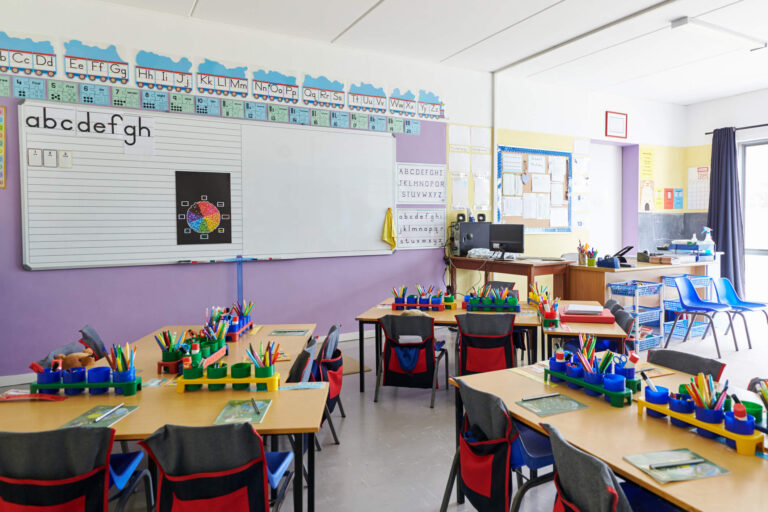Make the most of story time with the children you teach. Create an engaging and literacy-building lesson plan for your Pre-K students around one of our favorite books: Julián Is a Mermaid by Jessica Love. First, watch read alouds of the book and see how you can tie the story into activities for your students.
Video: Julián is a Mermaid, START Read 1
The first read focuses on explaining the key events of the story and pushing in target vocabulary which helps children understand the story and builds comprehension.
Video: Julián is a Mermaid, START Read 2
This second read focuses on the characters’ thoughts and feelings. Helping children understand the perspective of others is vital for reading comprehension and important to help foster empathy and compassion.
Tying it Together
Use easy conversation starters to help support your students’ learning from this week’s book. Guide children with questions and support their answers by repeating what they say and expanding on it, while encouraging use of the new words.
Target Vocabulary |
Conversation Starters |
| Transform – change into something else | He changed his clothes and put plants in his hair so that he could transform. Ask your class, “What did Julián transform into?” During the week, ask students, “If you could transform into anything, what would you transform into? Why? |
| Celebrate– When you do something special to say this day is different | Julián is celebrating with all the mermaids. They are all dressed up and walking in a parade! Ask your students, “Why do you think they are celebrating?” Have a conversation about how as a class you can celebrate together. Discuss celebrating the things that make us unique* (previous target word) and special. |
| Supportive– when someone helps you and believes in you | Ask, “What does Julián’s abuela do to show she supports him? Ask students, “Who is supportive to you? What does that person do that is supportive?” Talk about how we can be supportive of our friends at school. |
Children need multiple exposures to new words before the vocabulary “sticks.” Children with language differences, such as those who are learning English as a second language or children who are experiencing language delays, will need to hear new words in conversation even more.
During the week, point out when students do something to be supportive of each other. Look for things to celebrate with your students and talk about the different ways that people celebrate special days. Call attention to when characters in the books you read transform, like caterpillars into butterflies. Soon, you will hear the words become part of your students’ vocabulary.
Paving the Way to Reading
Word Awareness
We have been working for several weeks on supporting your students with being able to hear that sentences are made up of separate words. Being able to notice the sounds of spoken language is directly linked to later reading success! Phonological awareness skills develop along a continuum, from larger to smaller units of sound. Word awareness is just the beginning!
Here is another fun, engaging way to practice with your students:
Tell your students about a time when you were a child, and you were trying to learn the words to the song, “The Itsy-Bitsy Spider.” Explain how you had a hard time learning the song because you couldn’t hear the separate words. Say the words of the song as you give one clap for each word. Use a song or rhyme your child is familiar with so that they are focusing on the words rather than learning the song.
The itsy-bitsy spider,
Climbed up the waterspout.
Down came the rain
And washed the spider out.
Out came the sun
And dried up all the rain.
The itsy-bitsy spider climbed up the spout again.
Repeat with children giving one clap (or one stomp, one jump) for each word
Alphabet Knowledge
Talk to your students about the first letter of their first names. Describe what it looks like (curvy line, straight line, etc.) Go on a letter scavenger hunt around the classroom using old magazines, books, and other environmental print to see how many of “their” letter they can find. Explain to each student how they can tell it is their letter, reminding them of what it looks like. “Tom, I can tell it is a T because it has a long, straight line coming down and a straight line across the top. It is the letter T.”
To enforce this skill in an all-virtual setting, invite caregivers to help. Give them the letter description you have used to describe their child’s first letter. Encourage families to strengthen this knowledge by going on a scavenger hunt in their own home, at the grocery store, or even while stuck in traffic.
Growing Conversation Skills with TALK
Learn how you can use the TALK Strategy to build your student’s conversational skills, connect with them in a meaningful way, and let them know that what they think, feel, and have to say is important. Watch this video to learn about it! You can also share this video with your families so they can become experts in communicating with their children.
Monitoring Your Students’ Progress
After watching both reads, it is your students’ turn to share the story of Julián is a Mermaid showing you what they’ve learned! Say to them, “Remember the book we heard this week about Julián and how he transformed himself into a mermaid? Now that you know it so well, you get to tell the story! I wonder why Julián’s abuela brought him to the mermaid parade. Let’s think about this as we talk about what happened in the story.” Give every child the opportunity to participate. If you can have individual time with your students, this is a great time to have this conversation.
As your class talks about the story, ask them open-ended questions about what happened and how the character felt.
- What did Julián imagine when he was sitting on the subway train?
- How did Julián transform himself into a mermaid?
- How did Julián feel when his abuela first saw him dressed up like a mermaid?
As you ask questions about the story, try using the TALK Strategy shared above and support your students’ answers using our START Ladder with Safety Nets to converse on their level.
Tune In: Get on their level and really let them know that you are interested in what they think and have to say about the book.
Ask Questions: Try the examples above or any questions that help your students’ share the story.
Lift Language: When a student answers you, honor and support their answer, even if it is off-topic, by adding to it with complex sentences, target words, and correct grammar. When you do this, you are modeling the kind of language you want your student to use in the future.
Keep it Going: Try for at least five back-and-forth exchanges with the student.
Paving the Way to Reading Check-In
Word Awareness
Are your students starting to understand that sentences are made up of separate words? If they have mastered the Itsy-Bitsy Spider, try using other familiar nursery rhymes and songs. Songs, fingerplays, and nursery rhymes are a great way to play with the sounds of spoken language. Repetition of skills in a fun, engaging, and playful way helps young children gain mastery.
Continue working with your students on clapping, stomping, jumping, or patting out the words in familiar songs and nursery rhymes. Try using the Happy Birthday song to celebrate* (target word) the students who have a birthday coming up. Most children know and love this song! If your students have mastered this with longer, more complex sentences and have a good understanding of words in a sentence, you can move on to syllable awareness using some of the same activities.
Alphabet Knowledge
Are your students beginning to recognize the first letter of their name? A child’s name is very important to them. Make a big deal out of this being “their” letter and they will get excited about it, too!
Paving the way to reading takes time. We will continue to build on these skills, and by the end of the school year, your students will have a whole new skill set geared toward supporting them on their journeys to reading.


